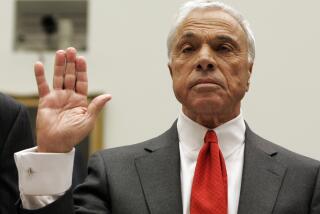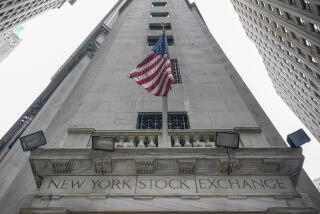Fears of a Worldwide Credit Crunch Intensify
- Share via
SINGAPORE
From Paris to Sao Paulo and Penang to Peoria, governments, financiers and company bigwigs are increasingly concerned that the final years of the 20th century could see a global credit crunch of unprecedented scale.
Amid growing fears that a sharp contraction of money flows like those already seen in Asia could undercut economic growth in the United States, Latin America and the rest of the world, the Federal Reserve Board last week lowered interest rates by a quarter of a percentage point--the second U.S. rate cut in less than three weeks.
“Few understand the nature and sense of urgency of today’s global credit crunch,” said Jose M. Barrionuevo, global strategist with Lehman Bros. Inc. “Fortunately, Federal Reserve Chairman [Alan] Greenspan does.”
Increasingly, the U.S. central bank is shouldering more responsibility not just for the U.S. economy, but for the globe’s.
Economists say the threat of a truly global squeeze did not exist until recently because physical and even ideological barriers created firewalls between countries and regions.
The advent of 24-hour markets, new technologies, globalization and the integration of advanced and emerging economies, however, now means that more than just data and deals circle the globe at the speed of light pulses. So too does fear, a key catalyst for worldwide credit deterioration.
Even as Asia shows signs of stabilizing its wobbly currencies--a necessary first step toward an eventual turnaround--mass psychology and a headlong flight from risk threaten to undermine even the most stable companies, jeopardizing millions of people’s livelihoods and adding to the gloom.
“It’s going to get worse,” said Michael A. Pritcher, Asia-Pacific vice chairman with Barclays Capital Asia Ltd. “You’re seeing already that money otherwise available is now drying up. It all feeds on itself.”
Extending credit is essentially an act of faith that borrowers--whether consumers with credit cards, homeowners with mortgages or giant companies issuing bonds--can pay back the money.
The collapse in Asian and Russian markets over the last 15 months has shaken that faith. In response, millions of lenders and investors around the world have made a mad dash for safe investments. Banks in turn have tightened lending requirements, called in marginal loans and refused to roll over short-term credit.
Portuguese bankers “are pulling out of emerging markets,” said Horacio da Silva Roque, chairman of Portugal’s Banco Internacional do Funchal. “It’s exactly the same as you see everywhere else. They want to be as safe as possible.”
Effects of a Squeeze
Because credit is a lifeblood for business, the “real economy” quickly feels the squeeze as the system constricts. Companies start losing orders, cutting suppliers and laying off workers. Consumers stop spending. Marginal companies go out of business.
If left to deteriorate long enough, analysts fear, the growing pessimism could make the system seize up, leading to a worldwide downturn.
Not all financials experts are convinced there is much risk of a global credit crunch. “I think the danger is overplayed,” said John Ross, Asia-Pacific chief executive of Deutsche Bank.
Others believe the worst will be avoided now that policymakers and central bankers are responding by lowering interest rates.
Robert Stenram, a Tokyo-based executive vice president of Swedbank, however, says a danger is that the crisis could become a self-fulfilling prophecy. At last week’s World Bank and International Monetary Fund meetings in Washington, bankers traded notes in the corridors about shaky balance sheets, sovereign debt and currency risks just days after Russia’s economy imploded and the mammoth Long-Term Capital Management hedge fund nearly collapsed. As he watched, Stenram says, many vowed to fly straight home and review their own lending practices. That in itself “could add to the problem,” he said. “So much of it is about psychology.”
The risk-averse psychology soon filters down to even the lowliest of credit officers, bankers say. The officers quickly realize they’ll probably keep their jobs if they don’t extend any loans and that they could get sacked if their names are on a bad loan.
There is no easy way to quantify a credit crunch. A recent Federal Reserve survey reported that about a quarter of U.S. banks said they’d tightened their lending standards over the previous four weeks. U.S. real estate developers report more failed deals as funding dries up, said David Hale, global economist with Zurich Insurance Group. Others see similar signs.
“We’ve not had any difficulty ourselves getting credit,” said Gary Wendt, chairman and chief executive of General Electric Capital Corp., “but we’re seeing a backlog of transactions. It appears some of our customers are having trouble as the banks pull back.”
Might U.S. Suffer as Asia Has?
That said, recent U.S. concerns are a shadow of what’s already happened in emerging markets, especially in Asia. Once the darlings of bankers and investors for their high growth rates, these have become credit pariahs almost overnight.
The Institute of International Finance, a Washington think tank, expects stock and mutual fund investments in developing economies to plummet to $10.1 billion this year from $33.4 billion in 1996, even as commercial banks are forecast to lend them just $11.9 billion in 1998 compared with a 1996 peak of $113.3 billion.
“A lot of good companies are not getting loans,” said Kongkiat Opaswongkarn, president of Thailand’s Asset Plus Securities, at the World Economic Forum’s East Asia summit last week in Singapore. “And banks aren’t giving loans to small companies no matter what sector they’re in.”
In Japan and South Korea, a record wave of bankruptcies has hit small and medium-sized companies unable to keep their operations afloat, even as banks themselves struggle to survive.
U.S. software maker Novell says South Korean banks now insist on hard collateral for even routine loans. As bankruptcies have risen, Novell has cut out its own middlemen so it can see client debt problems earlier. “Clearly the risk compounds as you go through two or three hands,” said Keith Osborne, the company’s Asia-Pacific vice president.
In Malaysia, Ajit Saran, managing director of Nestle Malaysia Berhad, sees his grocery store and supermarket customers facing mounting problems paying their bills.
Birkart Southeast Asia, a Singapore-based warehouse and distribution company, says its salesman now spend half their time collecting debts, instead of cultivating new business.
The human costs of all this are enormous, of course. By some estimates, half of Indonesia’s 140 million people will fall below the poverty line by year-end.
“You have civil unrest or potential unrest in a lot of countries because the banks are not extending credit,” said Jack Rodman, Asia director of Ernst & Young Kenneth Leventhal. Elsewhere, millions of Asia’s middle class have seen the standard-of-living gains in the last two decades wiped out almost overnight.
That said, lenders are not all reacting in the same way.
“The Japanese have done quite a bit and quietly rolled over loans from the beginning, while the European and U.S. bankers took their satchels and ran,” said Amaret Sila-on, chairman of Thailand’s Financial Sector Restructuring Authority. “Asian people will remember who their friends were in times of need.”
Although there is never a good time for a credit squeeze, most experts say now is a particularly bad one. Given all the economic instability, the world needs more money in circulation--”liquidity,” in banker-speak--not less, to help developing countries rebuild, pave the way for painful reforms and spur consumer confidence.
Yet for many, the most important thing is to stop a cycle of worry that is feeding on itself. “There’s great fear,” said GE’s Wendt. “But if you look around, there’s lots of money still around. It’s a confidence crisis. If we all sit back, take a few days off and have a vodka, things will get better.”
(BEGIN TEXT OF INFOBOX / INFOGRAPHIC)
Arco’s Performance
Atlantic Richfield Co.’s stock performance in the 1990s has badly lagged the performance of international oil stocks in general and the blue-chip Standard & Poor’s 500 index, but Arco’s investors have been better-rewarded than those of the average domestic oil stock. Total returns (price change plus dividends) from Jan. 1, 1989 through Sept. 30, 1998:
*
S&P; 500: +261.7%
Avg. international oil stock: +259.8%
Arco: +90.2%
Average domestic oil stock: +53.9%
Source: Bloomberg News
More to Read
Inside the business of entertainment
The Wide Shot brings you news, analysis and insights on everything from streaming wars to production — and what it all means for the future.
You may occasionally receive promotional content from the Los Angeles Times.










